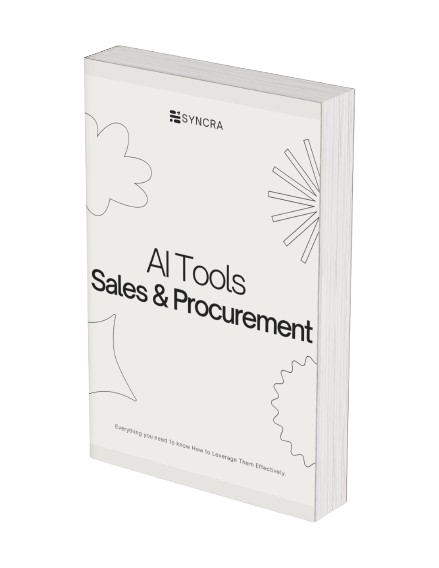
Want to know the best AI tools for your job?
We have created an e-book with the best AI tools for sales and procurement, and it is FREE!


In today’s data-driven world, ensuring the accuracy and consistency of your datasets is more important than ever. Whether you’re reconciling financial records, managing inventory, or verifying customer information, comparing Excel sheets and columns can be a time‐consuming task. This article explores common challenges, essential built-in functions, advanced techniques, and recommended tools that can streamline your data analysis process.
Many professionals encounter obstacles when working with multiple Excel sheets, including:
Discrepancies in Data Entries 📝: Finding differences between large datasets where even slight errors can lead to significant misinterpretations.
Merging Data 📑: Combining information from different sources while avoiding duplicates or omissions.
Validating Large Datasets 🔎: Manually checking thousands of rows for consistency can be error prone and inefficient.
Handling Data from Different Formats 📋: Sometimes data comes in various forms—from standard Excel files to tabular data extracted from emails—which complicates the comparison process.
Understanding these challenges is the first step toward implementing solutions that enhance data quality and reliability.
Excel offers a suite of functions that can help you quickly identify matches, differences, and duplicates. Some key functions include:
VLOOKUP & INDEX-MATCH:
Use these functions to cross-reference data between two sheets. For example, you can quickly find discrepancies in product codes or financial figures.
Tip: When data is not sorted, consider using INDEX-MATCH as it offers more flexibility than VLOOKUP.


Source: https://www.educba.com/vlookup-vs-index-match/
Conditional Formatting:
Highlight duplicate or unique values by applying rules that automatically change cell color or font. This visual aid can help you spot errors instantly without adding extra columns to your worksheet.
 Source: https://www.xlintelligence.co.uk/excel-conditional-formatting-hacks-transform-your-data-presentation
Source: https://www.xlintelligence.co.uk/excel-conditional-formatting-hacks-transform-your-data-presentation
IF and EXACT Functions:
Combine the IF function with the EXACT function for case-sensitive comparisons. This is particularly useful when comparing product IDs, customer names, or codes where the difference between uppercase and lowercase matters.
 Source: https://corporatefinanceinstitute.com/resources/excel/exact-function/
Source: https://corporatefinanceinstitute.com/resources/excel/exact-function/
These functions form the foundation of many Excel-based data comparison strategies, allowing you to create quick checks and detailed reports within your spreadsheet.
When basic functions aren’t enough—especially with large or complex datasets—advanced Excel tools can further streamline your workflow:
Power Query:
Use Power Query to automatically import, transform, and merge data from multiple Excel files or even external sources. Its automated cleaning and transformation features save time and reduce manual errors.
VBA Macros:
For repetitive tasks, VBA (Excel programming language) macros can automate data comparisons across sheets and workbooks. Whether you need to perform a full audit or schedule regular updates, macros can handle the heavy lifting.
Array Formulas:
Array formulas allow you to perform complex, multi-cell calculations that check for differences or calculate statistics across large ranges of data—all with a single formula.
By mastering these advanced techniques, you can significantly reduce the time spent on manual comparisons and improve your overall data accuracy.
While Excel’s built-in tools are powerful, third-party add-ins are many times easier to use, and offer more specialized out-of-the box functionality. Here are some popular options:
Microsoft Spreadsheet Compare & Inquire Add-In:
Great for side-by-side comparisons of two Excel workbooks, highlighting differences in values, formulas, and formatting. Here is a nice tutorial about it - Tutorial
Ablebits & Synkronizer:
These add-ins provide detailed difference reports and interactive merging capabilities, ideal for data analysts who need to combine datasets quickly and accurately.
RapidQuote:
RapidQuote is a specialized tool designed to extract and compare tabular data from both emails and Excel files.
What It Does: RapidQuote automates the extraction of structured and unstructured data from emails and Excel documents, then compares the tables to flag differences and highlight discrepancies.
Key Benefits:
Time Efficiency ⏱️: Quickly identify changes across datasets without manual data entry.
Enhanced Accuracy 🎯: Reduce errors by automatically matching similar data entries even when they originate from different sources.
Versatility 🛠️: Ideal for industries such as financial auditing, inventory management, and data quality control, where real-time data validation is crucial.
Integrating RapidQuote into your workflow means you can extend Excel’s capabilities—making your data comparison process even more robust and less labor intensive.
Accurate data comparison isn’t just an academic exercise—it has practical implications in various industries:
Financial Audits:
Verify consistency between different financial reports to identify errors, fraudulent entries, or calculation mistakes.
Inventory Management:
Compare inventory lists from multiple sources to ensure that stock counts are accurate and up-to-date.
Data Quality Control:
Regularly validate large datasets to catch and correct discrepancies before they affect business decisions.
Using the methods and tools outlined above, you can create reliable processes that save time and enhance decision-making.
Comparing Excel sheets and lists is a critical skill for professionals who need to ensure data accuracy and consistency. By leveraging built-in Excel functions, advanced techniques like Power Query and VBA, and integrating powerful third-party tools like RapidQuote, you can transform a once tedious task into a streamlined, efficient process.
Whether you’re an experienced data analyst or just starting out, adopting these tips and tools will help you unlock deeper insights from your data—ensuring that every decision is backed by accurate, reliable information.

We have created an e-book with the best AI tools for sales and procurement, and it is FREE!

